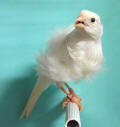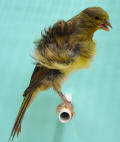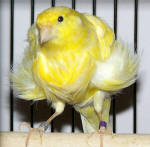|
PARISIAN
FRILL CANARY
In
addition to
these three
main kinds
of frill
there exist
equally a
certain
number of
secondary
frills
completing
the general
effect and
harmony of
the subject.
These are:
The
Head
Feathers
coming down
on one of
both sides
of the head
forming a
“skull-cap”.
2. Curled up
and rolled
in the form
of a
“helmet”. 3.
Sweeping
each side of
the face to
give a
“whiskered”
effect.
The Neck
A general
collar of
curled
feathers.
The Rump
Feathers
falling on
each side of
the base of
the tail,
similar to
the saddle
feathers of
a cockerel,
called “cock
feathers”.
The rump
must be long
and densely
feathered.
ELEGANCE
This is
brought
about by the
carriage,
which is
proud and
majestic, by
the
arrangement
of the
frills, and
by the
perfect
symmetry of
the bird. In
the Parisian
Frill two
forms of
carriage can
be
distinguished,
1. High
carriage
(well raised
up)
2. Low
carriage. (At
shows the
high
carriage
will always
be
preferred).
Flights
The flight
feathers
must be long
and as
regular as
is possible.
Legs and
Feet
Two types
can be
distinguished
which are
more or less
characterized
by the kind
of
feathering
on the leg:
1. Where the
thighs are
covered with
long
feathers
which also
cover the
rest of the
leg to some
extent (“trousered”
type). 2.
The type
where the
thighs are
covered with
short silky
feathering
without any
long
feathers
covering the
legs. At
shows a
“trousered”
subject will
always have
preference.
Tail
The tail
must be long
and
straight,
closely
folded, and
ending as
squa4ely as
possible. A
deeply
forked tail
is a fault,
as too is a
raised tail.
Condition
Being
essentially
and
exhibition
bird, the
Parisian
Frilled
Canary must
be presented
on the show
bench with
all the care
possible and
in
irreproachable
condition,
meticulous
cleanliness
and perfect
health
SCALE OF
POINTS
| Size and Shape: |
From 19 to 22 cm. Well Built. |
10 points |
| Feathering: |
Very even, Fine and long, or crisp and sharp. |
10 “ |
| Position: |
Well poised. Massive and symmetrical disposition of the feathers. |
10 “ |
| Mantle: |
Abundant and well develop, with frills reaching almost to the rump.. |
15 “ |
| Breast Feathers: |
Double frills, well furnished and symmetrical. |
10 “ |
| Flanks: |
Symmetrical with mantle and jabot. Rising well over the wings and shoulders. |
10 “ |
| Head and Neck: |
Frills on the head of the type “calotte” or the type “casquette”. Perfect transition from head
to body. |
8 “ |
| Tail Coverts: |
Falling evenly from the rump on either side. |
5 “ |
| Wings: |
Long and close to the body. |
5 “ |
| Legs and Feet: |
Well developed. Nails like corkscrew |
4 “ |
| Tail: |
Long and large. Type of quills in line. |
4 “ |
| Condition: |
Vigorous, with poise. General impression massive and symmetrical. |
8 “ |
| |
|
_______
100 points |
|


